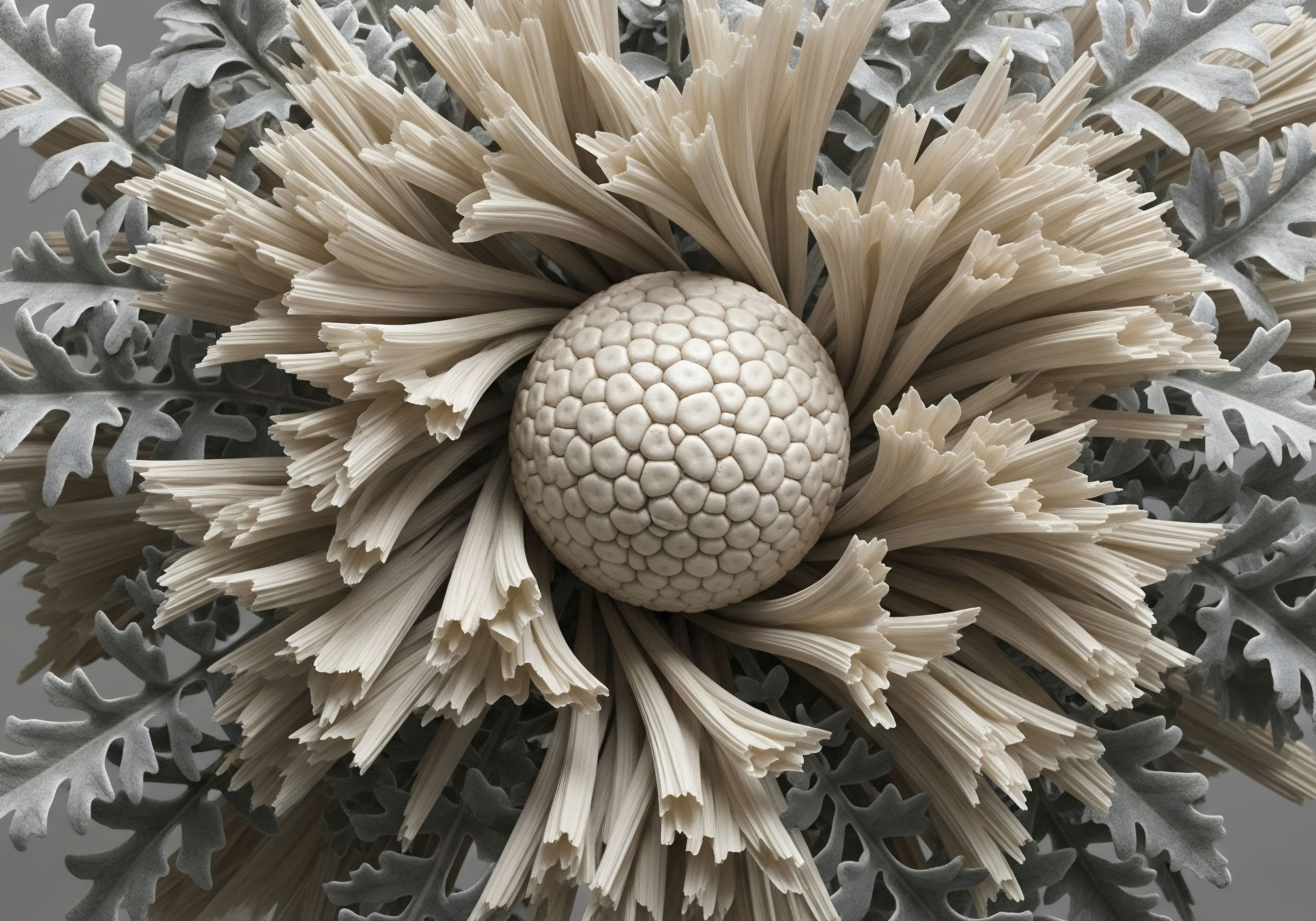

Fundamentals
The feeling of being out of sync with your own body is a deeply personal and often disquieting experience. You may notice a subtle decline in energy, a shift in mood that feels disconnected from your daily life, or a change in physical resilience that you can’t quite pinpoint.
This experience is a valid and important signal. It is your body communicating a change in its internal equilibrium. At the heart of this equilibrium is the endocrine system, an intricate network of glands and hormones that functions as your body’s primary chemical messaging service. Understanding this system is the first step toward reclaiming your vitality.
Hormones are signaling molecules that travel through the bloodstream to tissues and organs, instructing them on what to do, when to do it, and for how long. They regulate metabolism, growth, sleep, mood, and reproductive cycles. This constant, dynamic communication ensures your body can adapt to its environment, manage stress, and maintain a state of internal balance known as homeostasis.
When this communication network is disrupted, the messages become unclear, and the body’s functions can become compromised. The symptoms you feel are the direct result of these communication breakdowns.
A personalized wellness protocol is a strategic recalibration of your body’s internal communication system, designed to restore clear signaling and optimal function.
The goal of a personalized wellness protocol is to precisely identify where these communication lines are faltering and provide the specific support needed to restore them. This process begins with a comprehensive evaluation of your unique biochemistry through detailed lab work.
These diagnostics provide a quantitative look at your hormonal landscape, revealing the specific imbalances that correlate with your subjective experience. This approach moves beyond generic solutions and focuses on your individual biology. It is a partnership between you and your physiology, guided by clinical data, to rebuild your health from a foundational level.

The Language of Hormones
Your endocrine system speaks a language of feedback loops. The brain, specifically the hypothalamus and pituitary gland, acts as the central command. It sends out signaling hormones that travel to other endocrine glands, like the thyroid, adrenal glands, and gonads (testes in men, ovaries in women).
These peripheral glands then produce their own hormones, which travel throughout the body to carry out their specific functions. Simultaneously, these hormones send signals back to the brain, informing it of their levels in the bloodstream. This feedback allows the brain to adjust its own signals, either increasing or decreasing stimulation to maintain balance. It is a sophisticated, self-regulating system that, when functioning correctly, keeps your entire body in a state of dynamic harmony.
When external or internal stressors ∞ such as age, environmental factors, poor nutrition, or chronic stress ∞ interfere with this system, the feedback loops can become dysregulated. The brain might not send the right signals, or the glands may not be able to respond appropriately. The result is a cascade of hormonal deficiencies or excesses that manifest as the symptoms you experience. Personalized protocols are designed to intervene intelligently within these loops, providing the necessary components to help the system recalibrate itself.


Intermediate
Understanding that hormonal imbalance is a communication problem opens the door to targeted solutions. Personalized wellness protocols utilize specific therapeutic agents to restore clear signaling within the endocrine system. These interventions are meticulously tailored to an individual’s biochemistry, symptoms, and health objectives, as revealed by comprehensive diagnostic testing. The protocols are designed to work with the body’s natural pathways, supplying the necessary hormonal signals to re-establish physiological balance and alleviate symptoms.

Biochemical Recalibration for Men
For many men, the age-related decline in testosterone production, often termed andropause, leads to a significant reduction in vitality, cognitive function, and physical strength. A carefully managed Testosterone Replacement Therapy (TRT) protocol can address these issues directly. The standard of care often involves weekly intramuscular injections of Testosterone Cypionate. This bioidentical hormone restores serum testosterone to the mid-to-upper end of the normal range, directly addressing the deficiency.
A comprehensive male protocol extends beyond testosterone alone. It addresses the entire Hypothalamic-Pituitary-Gonadal (HPG) axis to ensure a balanced and sustainable outcome.
- Gonadorelin A key component of a modern TRT protocol is the inclusion of a Gonadotropin-Releasing Hormone (GnRH) analogue like Gonadorelin. Administered via subcutaneous injection, Gonadorelin mimics the natural signal from the hypothalamus, prompting the pituitary gland to release Luteinizing Hormone (LH) and Follicle-Stimulating Hormone (FSH). This action preserves natural testicular function and size, which can otherwise diminish during testosterone therapy.
- Anastrozole Testosterone can be converted into estrogen in the body through a process called aromatization. While some estrogen is necessary for male health, excess levels can lead to unwanted side effects. Anastrozole is an aromatase inhibitor, an oral medication that blocks this conversion process, thereby maintaining a healthy testosterone-to-estrogen ratio.
- Enclomiphene In some cases, Enclomiphene may be used. This selective estrogen receptor modulator (SERM) works at the pituitary gland to block estrogen’s negative feedback, which can further stimulate the production of LH and FSH, supporting the body’s innate testosterone production machinery.

Hormonal Optimization for Women
A woman’s hormonal journey involves complex fluctuations, particularly during the perimenopausal and postmenopausal transitions. Protocols for women are highly individualized, addressing the interplay between estrogens, progesterone, and testosterone to manage symptoms like vasomotor instability (hot flashes), mood changes, and loss of libido.
Low-dose testosterone therapy is an increasingly recognized component of female hormonal wellness. While testosterone is often considered a male hormone, it is vital for a woman’s energy, mood, cognitive clarity, and sexual health. A typical protocol might involve weekly subcutaneous injections of a low dose of Testosterone Cypionate.
This approach restores testosterone to optimal physiological levels for a female, often producing significant improvements in well-being. Depending on menopausal status, this is frequently combined with progesterone, which is essential for uterine health in women who have not had a hysterectomy and also provides calming, pro-sleep benefits.
Personalized hormone therapy is a process of providing the body with the precise biochemical signals it needs to restore its own finely tuned regulatory systems.

Growth Hormone Axis and Peptide Therapy
Another key area of personalized wellness involves supporting the growth hormone (GH) axis. GH is critical for tissue repair, metabolism, and maintaining lean body mass. Its production naturally declines with age. Instead of direct replacement with synthetic HGH, advanced protocols often use Growth Hormone Secretagogues (GHS).
These are peptides, or short chains of amino acids, that stimulate the pituitary gland to produce and release its own GH in a natural, pulsatile manner. This approach is considered safer and more aligned with the body’s innate rhythms.
The table below outlines some of the key peptides used in these protocols and their primary mechanisms of action.
| Peptide Combination | Primary Mechanism of Action | Key Benefits |
|---|---|---|
| Sermorelin | A GHRH analogue that directly stimulates the pituitary gland’s somatotroph cells to produce GH. | Improves sleep quality, enhances recovery, supports a more youthful body composition. |
| Ipamorelin / CJC-1295 | Ipamorelin is a selective GHRP that stimulates GH release, while CJC-1295 is a GHRH analogue. The combination provides a strong, synergistic effect on GH release with minimal impact on other hormones like cortisol. | Promotes lean muscle mass, reduces body fat, improves cellular repair and skin quality. |
| Tesamorelin | A potent GHRH analogue specifically studied for its ability to reduce visceral adipose tissue (belly fat). | Targets stubborn abdominal fat, improves metabolic parameters. |
Other targeted peptides, such as PT-141 for sexual health and Pentadeca Arginate (PDA) for tissue repair, can be integrated into a protocol to address specific individual needs, further demonstrating the personalized nature of this clinical approach.


Academic
A systems-biology perspective reveals that endocrine dysfunction is a systemic process, deeply interwoven with metabolic health and the inflammatory status of the central nervous system. The decline of gonadal hormones, specifically testosterone, instigates a cascade of events that extends far beyond simple reproductive function.
It actively contributes to a state of low-grade, chronic inflammation, particularly within the hypothalamus, the master regulator of both the endocrine and autonomic nervous systems. This neuroinflammatory state is a critical, and often overlooked, factor in the progression of age-related metabolic and hormonal decline.

The Hypothalamus as a Nexus of Decline
The hypothalamus contains the neurons that produce Gonadotropin-Releasing Hormone (GnRH), the primary signal that initiates the entire HPG axis. These neurons are exquisitely sensitive to their environment, which includes circulating hormones, metabolic substrates, and inflammatory signals. Research demonstrates that a high-fat diet, a common feature of modern lifestyles, can induce localized inflammation within the hypothalamus, impairing neuronal function.
This diet-induced inflammation can directly suppress GnRH output, contributing to the development of secondary hypogonadism, where the testes are functional but receive inadequate stimulation from the brain.
Testosterone itself has potent anti-inflammatory properties within the central nervous system. It has been shown to suppress the activation of microglia, the brain’s resident immune cells, and reduce the production of pro-inflammatory cytokines like TNF-α and IL-6. When testosterone levels decline with age or due to metabolic stress, this protective, anti-inflammatory shield is lowered.
The result is an environment where neuroinflammation can become self-perpetuating, further damaging GnRH neurons and locking the HPG axis in a state of suppression. Evidence shows that testosterone deprivation is associated with increased oxidative stress and an upregulation of inflammatory proteins within the brain.
The restoration of testosterone through a personalized protocol is a direct intervention against the cycle of neuroinflammation and metabolic dysregulation that drives systemic decline.

How Does a Protocol Interrupt This Vicious Cycle?
A personalized TRT protocol does more than just elevate serum testosterone. It actively works to break the feedback loop between hormonal decline and neuroinflammation. By re-establishing physiological testosterone levels, the protocol restores the hormone’s intrinsic anti-inflammatory and neuroprotective effects within the hypothalamus.
Studies in animal models show that testosterone therapy can preserve the hypothalamus from inflammation induced by metabolic syndrome, protecting the upstream neuronal machinery that regulates GnRH. This action helps to restore the sensitivity of the HPG axis and protects its long-term functional integrity.
The table below details the systemic effects of testosterone deficiency and how a personalized protocol provides a corrective, multi-system response.
| System Affected | Consequence of Low Testosterone | Mechanism of Protocol-Based Recovery |
|---|---|---|
| Central Nervous System | Increased hypothalamic inflammation, microglial activation, and oxidative stress. Impaired GnRH pulsatility. | Testosterone directly suppresses pro-inflammatory cytokines and reactive oxygen species, protecting neuronal function and restoring HPG axis sensitivity. |
| Metabolic System | Increased insulin resistance, accumulation of visceral adipose tissue, and systemic inflammation. | Optimal testosterone levels improve insulin sensitivity, promote lean muscle mass, and reduce inflammatory signals originating from adipose tissue. |
| Musculoskeletal System | Decreased muscle protein synthesis (sarcopenia) and reduced bone mineral density. | Testosterone directly stimulates androgen receptors in muscle and bone cells, promoting growth and preserving structural integrity. |
Furthermore, the use of peptides like Ipamorelin/CJC-1295 complements this process. By stimulating the GH/IGF-1 axis, these peptides promote the growth of lean muscle tissue. Muscle is a highly metabolically active organ, and increasing muscle mass improves glucose disposal and insulin sensitivity system-wide.
This metabolic improvement reduces the overall inflammatory burden on the body, including the hypothalamus, creating a positive feedback loop that supports endocrine recovery. This integrated, systems-level approach demonstrates that restoring the function of one part of the endocrine system can have profound, beneficial effects across the entire biological network.

References
- Bhasin, Shalender, et al. “Testosterone Therapy in Men with Hypogonadism ∞ An Endocrine Society Clinical Practice Guideline.” The Journal of Clinical Endocrinology & Metabolism, vol. 103, no. 5, 2018, pp. 1715-1744.
- Vignozzi, Linda, et al. “Neuroprotective Effects of Testosterone in the Hypothalamus of an Animal Model of Metabolic Syndrome.” International Journal of Molecular Sciences, vol. 22, no. 4, 2021, p. 1568.
- Atallah, A. et al. “Involvement of Testosterone Signaling in the Integrity of the Neurovascular Unit in the Male ∞ Review of Evidence, Contradictions, and Hypothesis.” Neuroendocrinology, vol. 111, no. 1-2, 2021, pp. 98-113.
- Sigalos, J. T. & Zito, P. M. “The Safety and Efficacy of Growth Hormone Secretagogues.” StatPearls, StatPearls Publishing, 2023.
- “The 2017 Hormone Therapy Position Statement of The North American Menopause Society.” Menopause, vol. 24, no. 7, 2017, pp. 728-753.
- Goh, V. H. & Tong, T. Y. “The relationship between circulating testosterone and inflammatory cytokines in men.” Aging Male, vol. 20, no. 3, 2017, pp. 159-165.
- Wang, K. et al. “Toward Systems-Level Metabolic Analysis in Endocrine Disorders and Cancer.” Endocrinology and Metabolism, vol. 38, no. 6, 2023, pp. 594-609.

Reflection

Your Biology Your Story
The information presented here provides a map of the complex biological systems that govern your health and vitality. This knowledge is a powerful tool, shifting the perspective from one of passive symptom management to one of active, informed self-stewardship. The path to endocrine recovery is rooted in understanding the unique narrative your own body is telling through its symptoms and its biomarkers. The sensations you feel are real, and they are pointing toward an underlying physiological truth.
This journey is about more than just correcting numbers on a lab report. It is about reconnecting with your body’s innate capacity for balance and function. The science provides the framework, but your personal experience is what gives it meaning.
Viewing your health through this lens allows you to become a collaborative partner in your own wellness, making decisions based on a deep and respectful understanding of your own intricate biology. The next step is a personal one, involving a deeper inquiry into your own health story and seeking guidance that honors its unique chapters.

Glossary

endocrine system

personalized wellness

pituitary gland

personalized wellness protocols

testosterone replacement therapy

testosterone therapy

gonadorelin

anastrozole

growth hormone secretagogues

growth hormone

central nervous system

metabolic health

hpg axis




